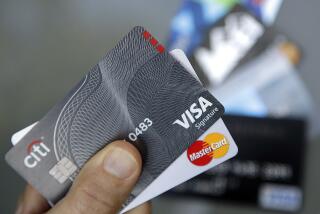Bank’s Payment Mistake Has Pricey Consequences for Customer
- Share via
With one $105.11 exception, I’m delighted by online bill paying.
The process of setting up online banking with Wells Fargo earlier this year was a little tedious. For each bill, I filled out a form with addresses and account numbers. A minor hassle: The template lines provided by Wells Fargo aren’t wide enough for some long street names or account numbers.
For the record:
12:00 a.m. June 3, 2000 For the Record
Los Angeles Times Saturday June 3, 2000 Home Edition Business Part C Page 3 Financial Desk 2 inches; 56 words Type of Material: Correction
Online banking--Bank of America’s online bill-paying service is free only to customers of the bank’s all-ATM service with direct deposit of monthly checks, and to those with service plans requiring minimum monthly balances of $10,000 or more. All others pay $5.95 per month, waived for the first three months. The price of the bank’s service was incorrectly reported in Thursday’s Business section.
Once I’d done this, the monthly ritual of bill paying suddenly took about 10 minutes instead of an hour. No check writing. No stamping. No envelope licking. Sign on to the computer and the Wells Fargo Web site, check the bills I want to pay, fill in an amount and date for each, click once. Bills paid. Record stored online.
Bank of America charges nothing for this service, which makes sense, because the bank takes advantage of the float between the date you assign for payment and the date the payment clears. Wells Fargo, after two free months, charges $5 a month for online banking. But I figure I’m saving that much or more in stamps each month. (Sending 20 bills costs $6.60 in stamps.)
For the most common bill collectors, say the gas company or major Visa accounts, online banking takes place electronically. But here’s the curious thing. If I’m paying a bill to a business not in its electronic directory, Wells Fargo appears to do the same thing I used to do: Write out a check, address an envelope and send it by snail mail.
On the very first month of online bill paying, I dutifully included my biggest monthly bill--my home mortgage--which is being serviced by a company in Texas. Soon I received a notice saying I’d missed a mortgage payment, noting that my credit rating was at risk and dunning me $105.11.
The mortgage servicing company was quite reasonable when I called. In fact, they confirmed that the Wells Fargo payment had finally arrived at their office--about 10 days late--and then had been properly assigned to my account.
It was late, apparently, because the envelope, handwritten, had the wrong address on it. I know this because the servicing firm made a copy and sent it to me. They quickly agreed not to count the episode against my credit history but wouldn’t forgive the late fee.
So I paid it. By hand. And I’ve continued to make my mortgage payment by hand ever since.
Meanwhile, all my other bills have been getting paid.
I queried Wells Fargo several times by e-mail, getting meaningless or unintelligible responses.
Finally I called the 800 number and, after four calls, got a supervisor who gave me the bad news. Technically Wells Fargo doesn’t owe me anything because I had scheduled my house payment on the 5th of the month, which falls into the mortgage company’s 15-day grace period. Wells Fargo is not liable for anything if you schedule a payment during a grace period. No matter that I had scheduled the payment 10 days before it was due and that Wells Fargo had erred on the address.
She offered to talk with my mortgage company if I would set up a conference call. She offered to waive one of my monthly $5 fees.
When I suggested I’d write about it instead, she said, “In that case, make sure to tell your readers to pay attention to all the terms and conditions.”
Hello Bank of America.
More to Read
Inside the business of entertainment
The Wide Shot brings you news, analysis and insights on everything from streaming wars to production — and what it all means for the future.
You may occasionally receive promotional content from the Los Angeles Times.










